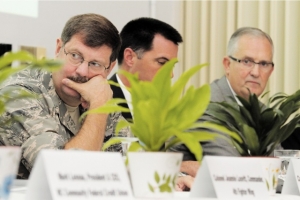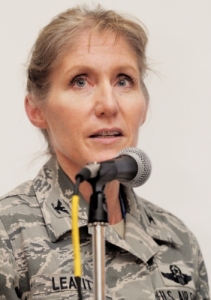Leaders talk about base relationship
By Kenneth Fine
Published in News on October 10, 2012 1:46 PM

News-Argus/TROY HERRING
From left, Col. Gregory Gilmour, left, 916th Air Refueling Wing commander; City Manager Scott Stevens; and Wayne County Chamber of Commerce Military Affairs Committee executive chairman Jimmie Edmundson participate in the chamber's annual State of the Military event. Kicking off the gathering was a presentation by 4th Fighter Wing Commander Col. Jeannie Leavitt.

News-Argus/TROY HERRING
Col. Jeannie Leavitt speaks during the State of the Military address held at the Goldsboro Country Club on Tuesday. The colonel updated local leaders on events at the base and discussed the wing's relationship with the community as well as other issues.
They talked about current and future deployments -- just what the men and women stationed at Seymour Johnson Air Force Base have done, and will do, in defense of their nation.
They talked about what the installation will look like in the future -- how the runway is currently closed so crews can replace several concrete slabs; what money budgeted for renovation of a hangar and construction of a new medical facility would do.
They even took the time to, again, thank the Wayne County community for its unwavering support.
But the focus of the Wayne County Chamber of Commerce-sponsored State of the Military event that unfolded late Tuesday morning at the Goldsboro Country Club was a contentious issue that has made headlines since July: the proposed construction of a wind farm in Beaufort County.
4th Fighter Wing Commander Col. Jeannie Leavitt told the crowd that the placement of nearly 50 turbines near the Dare County Bombing Range would have a negative impact on her F-15E crews' ability to complete their training syllabus -- that the Strike Eagle is the only DOD aircraft required to maintain a low-level capability.
But as a member of the military, Leavitt has to be careful about offering an opinion on the project.
So her job, she said, was to "state the impact," to let officials know how critical Seymour Johnson is to the training of "100 percent" of the F-15E aviators in the Air Force and how critical the Dare County range is to that mission.
"It's not a decision for the military. It is a decision for the state of North Carolina, where and when renewable energy sources are built. For us, it's our responsibility to state what the impact would be on the 4th Fighter Wing and our ability to accomplish our mission," she said.
And that mission, the colonel added, is unlike that of any wing and base in the nation.
"Since the mid-1990s, any Strike Eagle pilot or WSO who flies this airplane was trained right here at the 4th Fighter Wing at Seymour Johnson Air Force Base," Leavitt said. "So we are really the heart of the Strike Eagle community. Our mission is very important. And low-altitude training airspace is very important to us as well."
Military Affairs Committee member and the group's Executive Committee chairman, Jimmie Edmundson, doesn't have to be careful about stating his opinion.
So he explained that the Invenergy Pantego Project has the potential to jeopardize Seymour Johnson in the event another round of base closures occurs -- that placing 41 turbines within the base's most frequently used low-level training route "would almost certainly mean the loss" of the two F-15E training squadrons that every Strike Eagle aviator in the nation is required to graduate from.
"If you lose that, that could also pose other threats from a BRAC standpoint, so it's a big issue," he said. "It should be obvious to anyone that you cannot train at 500 feet with 500-foot turbines located in your training space. ... So you can see, having 41 of those wind turbines in that route is a serious situation."
And if local residents do not remain diligent -- if they don't contact elected officials and demand the relocation of the wind farm -- it could, in the worst-case scenario, mean the loss of not only a military installation the community has taken so much pride in for so long, but the $500 million-plus a year the Air Force base pumps into the economy.
"Should we be concerned?" Edmundson said. "Absolutely."
Other potential threats to the base were also discussed during the meeting, albeit for far less time.
Goldsboro City Manager Scott Stevens said he and his staff, with guidance from the City Council, are continuing efforts to protect Seymour Johnson from encroachment and its aviators from birds that are drawn to the Constructed Wetlands located just outside the installation gates.
But it was clear that, in the near future, the Pantego Project will continue to be the hot-button issue of choice for local advocates of both the base and the money it brings to Wayne.
